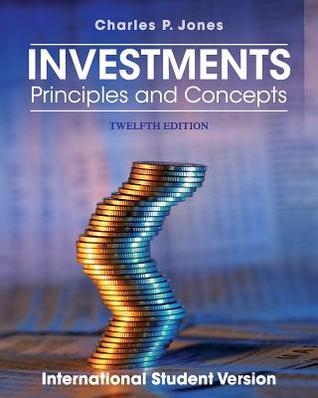
chapter 1
Investing is
an Important
Activity
Worldwide
Suppose you are fortunate enough to receive an inheritance of $1 million from a relative. She specifies only that you
must invest this money intelligently in financial assets within the next six months, and not spend it on con-
sumption, and that you must be answerable to a trustee who has the final say if you fail to make reasonable decisions.
You now face an enviable task—building a portfolio of stocks, bonds, and so forth—and you quickly realize that not
only do you not know all the answers, you don’t even know some of the questions.
Having had a finance course in college, you learned about return and risk, but now you must really understand
what these variables mean. You have heard some people talk about making a “killing in the market,” but common
sense tells you it can’t be all that easy. Like the prospective investor asked the broker when the latter was showing him
the yachts belonging to other brokers, “Where are the customers’ yachts?” Also, you have on several occasions read
about fraudulent investment schemes leaving people broke, but wiser. And so you realize you have your work cut out
for you. You need to identify the important issues, ask the right questions, and learn the basics about successful
investing.
You can, in fact, construct and manage your portfolio, as the following chapters will show. With a little tenacity,
you can be on your way to an intelligent investing program, because basic knowledge can go a long way. Let’s get
started.
Chapter 1 provides the foundation for the study of Investments by analyzing what investing is all about. The
critically important tradeoff between expected return and risk is explained, and the major issues that every investor
must deal with in making investment decisions are analyzed. An organizational structure for the entire text is provided.
AFTER READING THIS CHAPTER YOU WILL BE ABLE TO:
⁄ Understand why return and risk are the two critical
components of all investing decisions.
⁄ Appreciate the scope of investment decisions and
the operating environment in which they are made.
⁄ Follow the organization of the investment decision
process as we progress through the text.
An Overall Perspective on Investing
l In less than two years, from its peak in March 2000, the S&P 500 Index, a measure of
large stocks, subsequently lost about 50 percent of its value, while the NASDAQ Stock
Market lost about 75 percent of its value. In less than two years during 2000–2002,
investors lost $5 trillion, or 30 percent of their wealth in stocks. In 2008–2009 stock
market volatility was even greater. In only two months in 2011, $3 trillion in stock
market wealth disappeared in the United States, and $8 trillion globally. With volatility
like this, should most investors avoid stocks, particularly for their retirement plans?
l Following the financial crisis of 2008, interest rates on U.S. Treasury securities dropped
to record lows, in some cases close to zero. In early 2012, Germany sold six-month
Treasury securities with a negative yield. Why would investors continue to invest in
these debt securities, sometimes stampeding to invest in them?
l Almost everyone says stocks have always outperformed Treasury bonds over long
periods of time, such as 30 years. Is this an accurate statement?
l Many company employees with self-directed retirement plans have none of their funds
invested in stocks, although over the years stocks have significantly outperformed the
alternative assets they did hold. Is this smart?
l About two-thirds of all affluent Americans use financial advisors, a percentage that has
been increasing? Will you need one?
l For a recent 10-year period, only one-fourth of professionally managed stock portfolios
were able to outperform the overall stock market. Why?
l How can futures contracts, with a reputation for being extremely risky, be used to
reduce an investor’s risk?
l What is the historical average annual rate of return on common stocks and bonds? What
can an investor reasonably expect to earn from stocks in the future?
The objective of this text is to help you understand the investments field as it is currently
understood, discussed, and practiced so that you can intelligently answer questions such as the
preceding and make sound investment decisions that will enhance your economic welfare. To
accomplish this objective, key concepts are presented to provide an appreciation of the theory
and practice of investments.
Both descriptive and quantitative materials on investing are readily available. Some of
this material is very enlightening; much of it is entertaining but debatable because of the many
controversies in investments; and some of it is worthless. This text seeks to cover what is
particularly useful and relevant for today’s investment climate. It offers some ideas about what
you can reasonably expect to accomplish by using what you learn, and therefore what you can
realistically expect to achieve as an investor in today’s investment world. Many investors have
unrealistic expectations, and this will ultimately lead to disappointments in results achieved
from investing—or, worse, the loss of all of their funds in a fraud or scam.
Just Say NO! Prepare yourself to say NO! Learning how to avoid the many pitfalls
awaiting you as an investor—in particular, investing scams and frauds—by clearly under-
standing what you can reasonably expect from investing your money may be the single most
important benefit to be derived from this text. For example, would you entrust your money to
someone offering 36 percent annual return on riskless Treasury securities? Some 600 investors
did, and lost some $10 million to a former Sunday school teacher.
In February 2009, the SEC filed a complaint alleging that R. Allen Stanford and James
Davis operated a massive Ponzi scheme, misappropriating billions of dollars of investors’
money. According to the complaint, the $8 billion fraud involved certificates of deposit
promising overly high rates of return. The size of this alleged fraud pales in comparison to the
Brief Summary of Book: Investments: Principles and Concepts by Charles P. Jones




